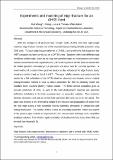| dc.contributor.author | Wang, Kai | |
| dc.contributor.author | Luo, Meng | |
| dc.contributor.author | Wierzbicki, Tomasz | |
| dc.date.accessioned | 2016-06-09T18:47:25Z | |
| dc.date.available | 2016-06-09T18:47:25Z | |
| dc.date.issued | 2014-03 | |
| dc.date.submitted | 2013-09 | |
| dc.identifier.issn | 0376-9429 | |
| dc.identifier.issn | 1573-2673 | |
| dc.identifier.uri | http://hdl.handle.net/1721.1/103093 | |
| dc.description.abstract | With the emergence of advanced high strength steels (AHSSs) and other light–weight materials, edge fracture has been one of the important issues evading reliable prediction using CAE tools. To study edge fracture behavior of AHSS, a comprehensive hole expansion test (HET) program has been carried out on a DP780 sheet. Specimen with three different edge conditions (milled edge, water jet cut edge and punched edge) are manufactured and tested. Results reveal that the hole expansion ratio (HER) of the present DP780 sheet is around 38 % for milled specimen and water jet cut specimen, and about 14 % for punched specimen. A novel method of a central hole specimen tension is also introduced for edge fracture study, showing a similar trend as found in HET. The paper briefly presents a procedure and the results for a full calibration of the DP780 sheet for plasticity and fracture, where a hybrid testing/simulation method is used to obtain parameters for Hill 48 plasticity model and modified Mohr–Coulomb fracture model. The finite element simulation gives an accurate prediction of HER, as well as the load displacement response and specimen deflection distribution in the hole expansion tests on uncracked material. The correlation between simulation and tests on central hole specimen also turns out to be very good. The paper also presents a very interesting insight of the initiation and propagation of cracks from the hole edge during a hole expansion test by numerical simulation in comparison with testing observation. The number of final cracks are accurately predicted. Other new aspects of the present paper include an improved 3D DIC measurement technique and a simplified analytical solution, from which a rapid estimation of displacement and hoop strain field can be made (see “Appendix 2”). | en_US |
| dc.description.sponsorship | Voestalpine AG | en_US |
| dc.publisher | Springer Netherlands | en_US |
| dc.relation.isversionof | http://dx.doi.org/10.1007/s10704-014-9937-5 | en_US |
| dc.rights | Creative Commons Attribution-Noncommercial-Share Alike | en_US |
| dc.rights.uri | http://creativecommons.org/licenses/by-nc-sa/4.0/ | en_US |
| dc.source | Springer Netherlands | en_US |
| dc.title | Experiments and modeling of edge fracture for an AHSS sheet | en_US |
| dc.type | Article | en_US |
| dc.identifier.citation | Wang, Kai, Meng Luo, and Tomasz Wierzbicki. “Experiments and Modeling of Edge Fracture for an AHSS Sheet.” International Journal of Fracture 187, no. 2 (March 11, 2014): 245–268. | en_US |
| dc.contributor.department | Massachusetts Institute of Technology. Department of Mechanical Engineering | en_US |
| dc.contributor.department | Massachusetts Institute of Technology. Impact and Crashworthiness Laboratory | en_US |
| dc.contributor.mitauthor | Wang, Kai | en_US |
| dc.contributor.mitauthor | Luo, Meng | en_US |
| dc.contributor.mitauthor | Wierzbicki, Tomasz | en_US |
| dc.relation.journal | International Journal of Fracture | en_US |
| dc.eprint.version | Author's final manuscript | en_US |
| dc.type.uri | http://purl.org/eprint/type/JournalArticle | en_US |
| eprint.status | http://purl.org/eprint/status/PeerReviewed | en_US |
| dc.date.updated | 2016-05-23T12:07:15Z | |
| dc.language.rfc3066 | en | |
| dc.rights.holder | Springer Science+Business Media Dordrecht | |
| dspace.orderedauthors | Wang, Kai; Luo, Meng; Wierzbicki, Tomasz | en_US |
| dspace.embargo.terms | N | en |
| dc.identifier.orcid | https://orcid.org/0000-0001-9390-9691 | |
| mit.license | OPEN_ACCESS_POLICY | en_US |
| mit.metadata.status | Complete | |
